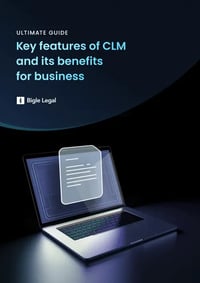What is CLM? Discover the Power of Contract Lifecycle Management
Contract Lifecycle Management, or CLM, is a legal tech solution revolutionising the way organisations manage contracts. When you think you have everything under control, an important contract gets lost in a pile of paperwork, unleashing a chain of emergencies and complications. Can you afford to make mistakes and waste time and resources due to failures in manual contract management? This is where CLM comes in with a solution that transforms chaos into order. Read on to find out how CLM can not only save your next big deal but also radically improve the efficiency of your entire organisation.
In this article, you will find:
- What is Contract Lifecycle Management or CLM?
- Why should my company have CLM software?
- What is the contract life cycle and what are the phases of the contract life cycle?
- Main features of CLM software
- Key benefits of Contract Lifecycle Management (CLM)
- 5 problems solved by CLM software
- Who uses CLM in companies?
- ROI of CLM software
- Explore the benefits of Bigle's next-generation CLM
What is Contract Lifecycle Management or CLM?
Contract Lifecycle Management (CLM) is a software that offers a comprehensive approach to contract management within an organisation, covering the entire lifecycle of a contract, from the request for a contract to its automated creation, negotiation, approval, compliance, electronic signature through to expiry or renewal. CLM software such as Bigle's provides a platform to manage the entire process, boosting efficiency and compliance in a company's legal operations.
This solution improves operational efficiency, reduces the risks associated with manual contract management, and optimises negotiations and compliance. By integrating a CLM into their operations, organisations can ensure greater contractual consistency, improve responsiveness to legal and regulatory changes, and gain valuable insights into performance and exposure to contractual risk.
Why should my company have CLM software?
As businesses recognise the intrinsic value of contracts, the adoption of technologies such as Contract Lifecycle Management (CLM) software is becoming an essential strategy. The benefits this software brings to the business range from digitising contract management to unlocking and driving the value that contracts bring to the business through technology.
One of the main benefits of CLM is the transparency it introduces within the organisation, through the management of legal operations. Contracts are spread across all areas of the business and, by centralising them, different departments gain clear, real-time visibility of contract terms, conditions and status, thereby aligning them more clearly with the company's strategic objectives.
In terms of security, CLM is critical in the age of digitalisation. It protects the sensitive information contained in corporate contracts and ensures that contracts are secure against unauthorised access, manipulation or loss. It also helps to ensure compliance with data protection regulations, an increasingly important aspect in today's global context.
Looking ahead, CLM positions companies to adapt quickly to market changes and emerging regulations while maintaining their competitiveness. CLM tools enable organizations to be more agile, react more quickly to business opportunities and effectively manage contractual risks, resulting in a substantial competitive advantage for both legal departments and companies in general.
Key benefits of Contract Lifecycle Management (CLM)
At the heart of every successful operation is the efficiency and security of contract management. By implementing CLM software, organisations can dramatically improve their contract processes. Let's explore the benefits of using a CLM.
Improved operational efficiency
- Automation of manual tasks and repetitive processes.
- Reduction of working time in the contract cycle.
- Implementation of standardised cross-departmental workflows.
Risk reduction
- Better management of contractual terms and conditions.
- Prevention of financial losses through early identification of non-compliance.
- Mitigation of legal disputes due to human error.
Improved collaboration
- Facilitates interaction between different teams and departments.
- Real-time collaboration tools for reviews and approvals.
- Centralisation of contract-related communication.
Data accessibility and security
- Centralised and restringed access to all contracts and related documents.
- Data protection through encryption and access control technologies.
- Compliance with personal and corporate data protection regulations.
Improved visibility and control
- Dashboard and tracking tools for a complete overview of contract status.
- Alerts and notifications to avoid unwanted automatic expirations and renewals.
- Ability to perform effective audits and compliance checks.
Advanced analysis and reporting
- Customised reporting for contract performance evaluation.
- Predictive analytics to identify trends and opportunities for improvement.
- Business intelligence tools to support strategic decisions.
Regulatory compliance
- Centralised update of contracts according to the latest regulations and laws.
- Facilitates adherence to local and international regulations.
- Reduces the likelihood of penalties for legal non-compliance.
5 issues solved by CLM software
Contract Lifecycle Management (CLM) software addresses a number of critical challenges faced by organizations in contract management, providing solutions to common contract management issues. Let's take a look at five of the main problems it solves:
Disorganization and difficult access to documents
Many companies still store contracts in physical formats or in disorganized systems, making it difficult to quickly access important documents when they are needed most and increasing the chances of misplacing them and creating security breaches. CLM centralizes and digitizes all contracts, allowing quick and easy access, as well as improving the searchability and security of documents.
Manual errors in contract management
Manual contract handling is susceptible to errors, from simple data entry mistakes to critical omissions in terms and conditions to forgetting key events and dates. CLM automates many of these tasks, reducing the possibility of errors and ensuring greater accuracy in contract management.
Inefficiencies in contract tracking and execution
Tracking the progress of multiple contracts through their lifecycle can be complex and prone to delays, even more so in large organizations. CLM provides a platform from which to automate manual processes, iron out inefficiencies and track the status of contracts, ensuring that deadlines are met and necessary actions are taken at each stage of the contract.
Contract collaboration and approval challenges
Coordination between multiple parties for contract review and approval can be time-consuming and complicated. CLM facilitates real-time collaboration, allowing stakeholders to review, edit and approve documents efficiently and virtually, speeding up the entire process and improving communication between teams.
What is the contract life cycle and what are the phases of the contract life cycle?
The contract life cycle describes all the stages a contract goes through, from its inception to its conclusion, renewal or termination. The life cycle of a contract can be divided into two main stages, pre-signing and post-signing. Within these two stages, there are five main phases: request, contract creation, negotiation and approval, electronic signature, and fulfilment of obligations and renewals or terminations.
The 7 phases of the contract life cycle
Each contract, within this pre-signing and post-signing phase, goes through the following seven phases:
- Request. A formal request by a person inside or outside the company to draw up a contract.
- Document automation. Preparation of the draft contract. Generation of the document using intelligent automated templates, guaranteeing coherence, agility and regulatory compliance from the start.
- Negotiation / Collaboration. The parties involved collaborate in the editing and discussion of clauses, in an environment that allows the monitoring of versions and comments in real time.
- Review / Validation. Validation of the contract by the legal department and relevant managers.
- Electronic signature. The signing of the contract by the parties involved.
- Repository. Storage in a centralised and accessible repository, where it can be easily consulted by authorised parties.
- Obligations, risks and renewals. Management of the contractual obligations and commitments of the respective parties; renewal or termination of the contract according to the conditions described in the contract.
Main features of CLM software
CLM software may vary slightly in its functionalities, but state-of-the-art software should include the following features:
- Legal ticketing or request management. It allows a company's internal users or external clients/collaborators to request legal services and manage those requests in a unified and centralised manner. It automates the assignment of tasks and facilitates the tracking and prioritisation of legal requests, improving the organisation and responsiveness of legal departments.
- Automated contract creation (document automation). CLM uses automated templates, customised with predefined rules, to automate the creation of contracts. Thus, documents are generated from forms automatically adapted according to the data entered and the user's specific needs, reducing the time and errors associated with manual drafting.
- Negotiation and workflows. The same CLM platform includes a module for contract negotiation, which allows multiple rounds of reviews and adjustments in a structured manner. In addition, it integrates workflows that automate the approval process according to internal hierarchies and policies, ensuring that all contracts go through the necessary reviews before signing.
- E-signature. The integrated e-signature functionality allows all parties to sign contracts remotely in a much simpler and more secure way, which speeds up the closing of agreements. This not only speeds up the process but also provides a secure and legally recognised method of contract enforcement.
- Repository. The CLM provides a centralised system for storing all of the organisation's contracts, making them easy to access, search and retrieve. This avoids the dispersion and leakage of documents. In addition, it includes alerts that automatically notify users of important dates, such as contract expirations, renewal dates and other critical milestones.
- Reporting. This functionality allows the generation of detailed reports on various aspects of contract management, including contract status, compliance, performance, and risks associated with contracts. Reports can be customised to provide specific insights and generate KPIs to help contract managers drive their business-facing work.
 Do you want to know in depth how CLM software works and what are the benefits it brings to companies? Download our ebook on the essential functionalities of a CLM and find out how it benefits companies.
Do you want to know in depth how CLM software works and what are the benefits it brings to companies? Download our ebook on the essential functionalities of a CLM and find out how it benefits companies.
What AI functionalities should a CLM include?
In addition to the CLM's functionalities, with the advent of artificial intelligence (AI) a state-of-the-art Contract Lifecycle Management software must include new functionalities associated with generative AI to further boost the contract lifecycle. Bigle's CLM includes a generative AI assistant that includes the following functionalities:
- Summarisation: review and synthesisation of documents, as well as summary generation.
- Legal Chatbot (Q&A): Question & Answering responses to specific questions about a document.
- Generation: drafting of quality content, such as clauses or contracts.
- Translation: translates into multiple languages with high accuracy.
Discover all the features of Bigle's AI and more to come. Join our waiting list.
Who uses CLM in companies?
Contract Lifecycle Management (CLM) software is used by professionals involved in the management, monitoring and analysis of contracts in various areas of companies. This includes roles focused on the management of all types of legal documents, compliance, risk management, operational efficiency and strategic collaboration between departments.
What type of company uses a CLM
Contract Lifecycle Management (CLM) software is essential for companies that handle a high volume of contracts and want to ensure and optimise efficiency and compliance in their operations. These tools are particularly valuable in large corporations and multinationals that operate in multiple jurisdictions and handle thousands of contracts simultaneously. However, it is not only large companies that benefit from CLM systems; medium-sized companies with complex legal operations also find these systems a crucial solution to manage their contracts effectively.
In which industries is CLM used
CLM systems are useful in all kinds of industries such as technology, telecommunications, consumer goods, healthcare and pharmaceuticals, construction, financial services and insurance, among many others.
Who can use CLM within my company?
Within a company, various roles can benefit from using a Contract Lifecycle Management platform, particularly roles related to the management of legal documents and contracts, either internally or externally to the company. Legal directors and in-house lawyers from legal departments, as well as managers and teams from Procurement, Sales, Human Resources, Finance or Marketing benefit from the automation and efficient contract management functionalities offered by CLM.
Why is CLM the right software for your legal department?
Contract Lifecycle Management or CLM software is emerging as one of the ideal legal tech tools for legal departments due to its ability to simplify and automate end-to-end contract management. In the legal department, where accuracy and speed are crucial but workloads are increasing, CLM helps to streamline and eliminate bottlenecks. A state-of-the-art CLM offers advanced tracking and alerting capabilities that ensure continuous compliance with contractual terms and current legal regulations. This optimises resources, strengthens the legal department's ability to respond proactively to any contingency, and improves risk management and operational efficiency.
ROI of CLM software
The return on investment (ROI) of CLM software is a crucial indicator for organisations seeking to justify its adoption. Effective implementation of Contract Lifecycle Management results in significant savings through increased security and efficiency of legal operations that serve to eliminate revenue leakage from contract processes. The improvements brought about by CLM can translate into increased operational efficiency and reduced costs, justifying the initial investment in CLM technology and marking contract processes not only for the present but also for the future.
Explore the benefits of Bigle's next-generation CLM
If you are interested in exploring how our CLM solution at Bigle can transform your legal department, we invite you to schedule a free and personalised demo with our legal operations specialists. Discover first-hand how our tool can adapt to your specific needs and contribute to the optimisation of your contractual processes. Schedule a demo and start your journey towards smarter and more secure contract management - we look forward to helping you take full control of your contracts!
Request a free demo with Bigle experts and discover our state-of-the-art CLM platform.
 By
By
..webp?width=500&height=292&name=The%20legal%20team%20talks%20about%20a%20project%20in%20their%20office.%20Bigle%20Legal%20article%20on%20Contract%20Lifecycle%20Management%20(CLM)..webp)
..webp?width=500&height=292&name=Hands%20of%20a%20lawyer%20in%20a%20suit%20working%20on%20a%20keyboard%20and%20selecting%20AI.%20Bigle%20Legal%20article%20on%20Contract%20Lifecycle%20Management%20(CLM)..webp)





